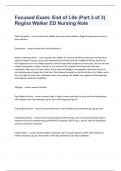Samenvatting
IPE Lecture 2: Class Notes + Summary of Chapter 2 (International Political Economy, IRO Year 2 Block 2)
- Instelling
- Universiteit Leiden (UL)
This document contains my class notes for Lecture 2 from the International Political Economy course, which is taught in Block 2 of the second year of International Relations and Organizations. It also contains my notes from the assigned readings, Chapter 2 from International Political Economy by Th...
[Meer zien]














